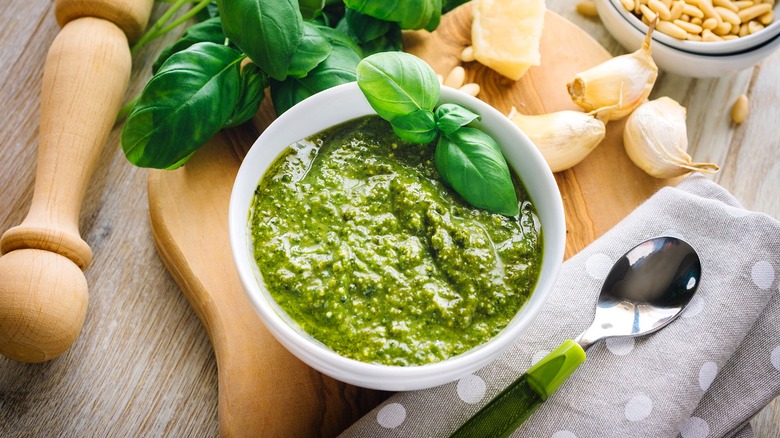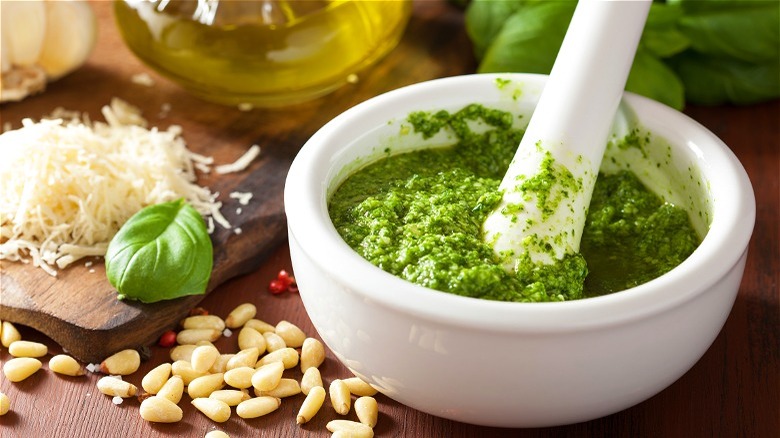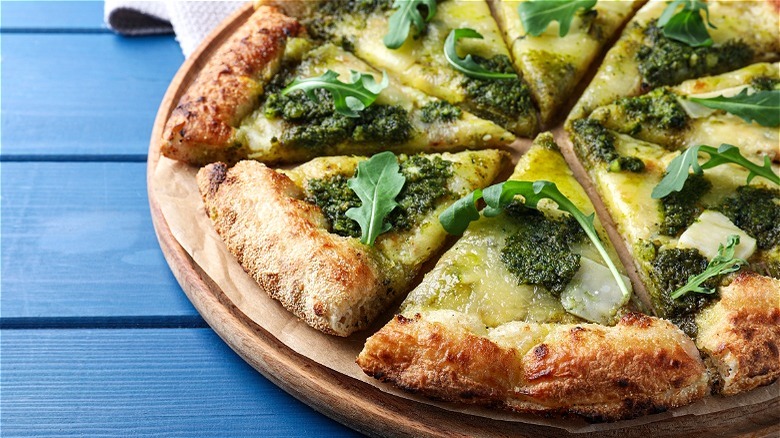Why It Pays To Make Your Own Pesto
We may receive a commission on purchases made from links.
There are certain foods that simply taste better when you take the additional steps to make them homemade. While BuzzFeed readers weigh in and conclude foods like mashed potatoes, soup, and iconic macaroni and cheese taste better when made in your own home kitchen, pesto may be one food worth making at home as well. But before we get into that, what is pesto exactly?
According to Food Network the word "pesto" translated from Italian to English means "to pound," hence the standard use of a mortar and pestle when making this fresh, aromatic sauce. Via Verdi claims this complex Italian sauce dates back to ancient Rome and was used initially in the Middle Ages in Liguria and Genova Italy as a simple walnut and garlic paste to prevent illness among travelers at sea.
The basil pesto you are most familiar with today, Pesto all Genovese, didn't enter the mainstream culinary world until 1865 in Emanuele Rossi's "La Vera Cocina Genovese" (per Via Verdi). Food Network declares the most popular variety to be comprised of garlic, pine nuts, olive oil, basil, and parmesan cheese. When you've had a long day at work, the last thing you might feel like doing is whipping up a homemade pesto, but there may be considerable differences between store-bought and homemade varieties.
For the brightest, freshest-tasting pesto, opt for homemade
As it turns out, making fresh pesto may pay off in the long run if bright flavors are what you're after. Food & Wine comprised an article of 29 food products professional chefs never buy in-store, and besides chicken stock and popcorn, executive chef of "Love & Salt" in Manhattan Beach, California, Chris Feldmeier believes homemade pesto is always worth the extra time and effort. This advice aligns with the efforts of TODAY when they taste-tested a slew of popular jarred pestos to find the best store-bought variety in 2022. While only one out of eight passed the taste test of several hungry Italians, in the end, the judges agreed nothing compares to the taste of home-ground pinenuts, basil, and parmesan cheese.
The Times Cooking recipe for basic pesto calls for less than six ingredients and is made with only a food processor. There are also ways to ensure you're making the best-tasting pesto at home. MasterClass suggests toasting pine nuts before adding them to your mixture. You can also try adding a touch of citrus to enhance the overall flavor of your finished product. Most importantly, treat those fresh basil leaves with care, and avoid adding them too early as you assemble the ingredients in your food processor. While basil may seem like the only fresh component to make or break an award-winning pesto, there are many other ingredients you can use to formulate your own recipe.
Basil pesto alternatives and creative ways to add them to your favorite dishes
When it comes to pesto, you can make this zesty sauce with many alternatives to basil and the usual pine nuts. BBC goodfood suggests 11 pesto alternatives including chive, broccoli, and kale. Giadzy, known as the website for all food content related to Giada de Laurentis, claims you can "make pesto out of anything." Creative alternatives are listed for pesto's main ingredients: Gruyere or Manchego cheese instead of parmesan, shallots instead of garlic, and even walnuts or almonds in place of pine nuts. Loaded with these tasty suggestions you're only a hop, skip, and a jump away from crafting the perfect zucchini pasta with almond pesto. But how can you incorporate these tasty pesto alternatives into your weekly food regime?
Apart from adding pesto to your favorite pasta, The Pioneer Woman suggests adding this aromatic sauce to pizza, sandwiches, and even salad dressings. If you find yourself with too much pesto at the end of the day, MasterClass advises freezing this vibrant sauce while it's still fresh to maintain the flavor structure of the raw garlic and herbs. To freeze, simply use an ice cube tray or glass jar. There aren't many downsides to making your own homemade pesto. Make your own recipe and see if you can taste the difference between homemade and store-bought varieties.


